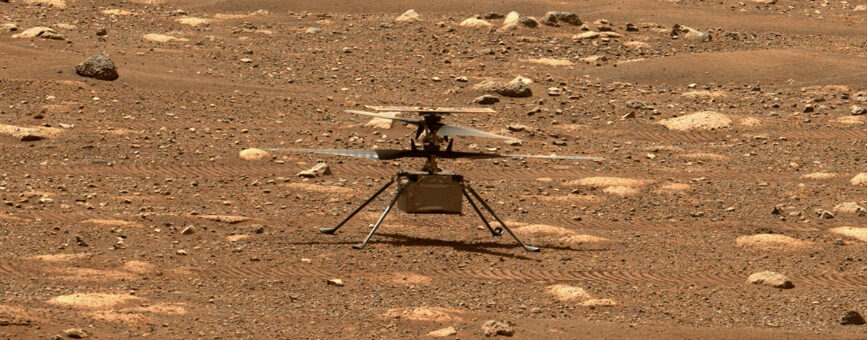
China’s Futuristic Foldable Mars Helicopter
China – China is developing a foldable helicopter they can deploy on Mars to collect samples that could be sent back to Earth on future missions. Early information states that the helicopter will be able to collect 100 grams of Martian rocks, which is just slightly less than a quarter of a pound, and transfer those rocks to a Mars lander or spacecraft that could fly back to Earth. China’s foldable helicopter could be deployed sometime in 2028 or 2030.
China’s Tianwen-3 Mars Mission
China’s Tianwen-3 Mars mission by the China National Space Administration (CNSA) hopes to launch the MarsBird-VII in 2028, but the spaceflight may occur as late as 2030. The foldable helicopter is estimated to have a takeoff weight of up to 8.8 pounds. The proposed rotocopter will contain four rotors, a fuselage, a sample collector, a landing gear, a solar panel, and an antenna. The landing gear and rotor arms will be designed to fold close to the fuselage for the launching and orbiting phases. The quad-copter will be designed to land and take off multiple times while it collects samples from a 1,640-foot radius around its lander.
MarsBird-VII Sample Collection
The MarsBird-VII will be able to pick up rocks that are approximately 40mm or 1.57 inches in diameter. Once collected, the rotorcraft can analyze the samples’ physical and chemical properties. Once it’s filled its sample container, the MarsBird-VII can fly back to its lander and give it the samples.
Aerodynamics on Mars
To date, Mars has been explored mainly by rovers that collect and analyze samples without sending those samples back to Earth. Because they are wheeled rovers, they have been chiefly confined to flat areas on the planet. Deploying rotorcraft or aerial vehicles would allow cliffs, steep hills, and even caves to be explored.
However, deploying flying vehicles on Mars is slightly challenging. The atmosphere of Mars is 1 percent that of Earth. That would be equivalent to performing aircraft operations in Earth’s thermosphere, roughly 62 miles above sea level. It’s also considered the boundary of our atmosphere and the edge of space. This means that the airfoils used on aircraft in Mars’ atmosphere would generate significantly less lift than they would on Earth. Despite that difficulty, it hasn’t thwarted the design of Mars aircraft. Since the 1970s, various aircraft, including airplanes, gliders, and rotorcraft, have been proposed and designed for flight on Mars. So far, rotorcraft have the most chance of success, and it’s been proven by NASA.
NASA’s Ingenuity Mars Helicopter
While the MarsBird-VII has attracted much attention, it isn’t the first rotorcraft to land on Mars. That honor belongs to NASA’s Ingenuity Mars Helicopter. It landed on Mars on Feb 18, 2021, after being launched from Earth on July 30, 2020. Since its landing, it’s completed 67 flights totaling 121 minutes and covered 9.5 miles. This is far better than NASA initially envisioned. The Ingenuity Mars Helicopter was only expected to make five flights.
The Difference Between NASA’s Ingenuity Mars Helicopter and China’s MarsBird-VII
NASA’s Ingenuity Mars Helicopter is not designed to be foldable. It contains two rotor blades stacked on each other, with a solar panel atop the blades. It’s also not designed to facilitate sample retrieval that could be returned to Earth.
By contrast, the MarsBird-VII is designed to be partially foldable, and it contains an arm for sample collection along with a sample collection container located on its belly. It’s anticipated that the rotorcraft will be able to assist in sending samples back to Earth, which would significantly advance the technology and greatly enhance the exploration of Mars.
When Could Earth Have Samples From Mars?
Scientists should have Martian samples to examine between 2028 and 2033. China is slated to have samples as early as 2033. However, NASA could have Martian soil and rock samples on Earth as early as 2028. However, no matter which country brings back samples first, Earth is slated to have its first official Martian rocks within the next decade.